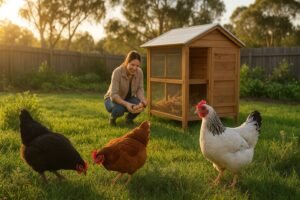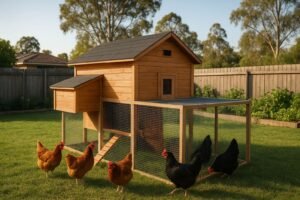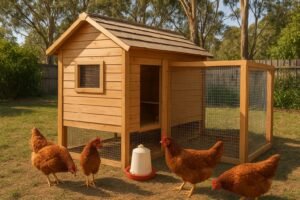The Australian summer can be a real scorcher. I’ll never forget the 45°C heatwave we had a couple of years back. I ran outside to find my chooks flat on the ground, panting like crazy. It was a mad dash with ice bricks and a hose to cool them down. When the temperature soars, we all run for cover, and it’s no different for our backyard chickens. Your chooks rely on you to help them beat the heat. Without proper shade, they can quickly suffer from heat stress, which can lead to lower egg production, illness, and in serious cases, can even be fatal. Discover all our strategies for keeping chickens cool in Australian summer.
Finding the best shade cloth solutions for your chicken run is one of the most important things you can do for your flock’s health and happiness. It’s a small investment for massive gains in chicken welfare and heat stress prevention.
This guide is your complete resource. We’ll cover why shade is so critical, break down the science of shade percentages, and review the top solutions for the unique Australian climate. We’ll also dive into step-by-step DIY shade cloth solutions, explore alternatives, and answer all your common questions. Let’s get your chooks sorted for summer. New to chickens? Learn the top mistakes to avoid.
Shade Cloth: A knitted or woven fabric designed to block a specific percentage (30-90%) of sunlight and harmful UV radiation. It is used in agriculture and horticulture to reduce air and surface temperatures, protecting livestock, plants, and people from heat stress. A quality 80% shade cloth can reduce perceived temperatures by 5-11°C.
Understanding Heat Stress in Australian Backyard Chickens
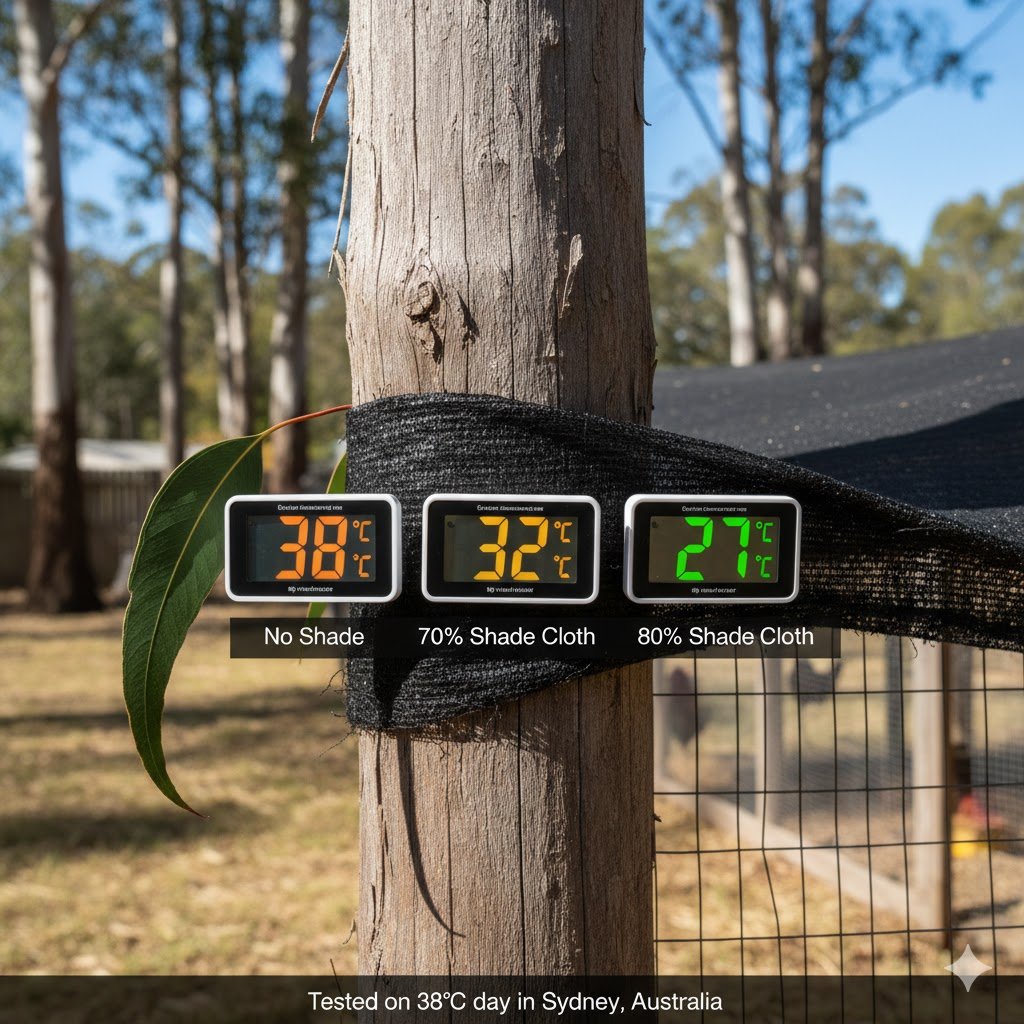
Chickens can’t sweat like humans do. Their main way to cool down is by panting, which takes a lot of energy and becomes inefficient in high humidity. When the temperature inside the coop or run gets too high, they simply can’t cool themselves fast enough. Of course, some chicken breeds handle Australian heat better than others.
This is when heat stress begins. According to RSPCA Australia, a chicken’s ideal temperature zone (or ‘thermoneutral zone’) is between 10°C and 20°C.
- Above 26°C: Chickens start to feel the heat and will adjust their behaviour.
- Above 29°C: Heat stress begins, and you’ll see the warning signs. Dine-A-Chook Australia notes this is a key temperature for Australian keepers.
- Above 35°C: This is the danger zone for severe heat stress, especially if it’s humid.
- At 40°C+: The situation becomes life-threatening, as a chicken’s body temperature is around 41°C, and they can no longer cool themselves.
What Heat Stress Actually Looks Like (The Warning Signs)
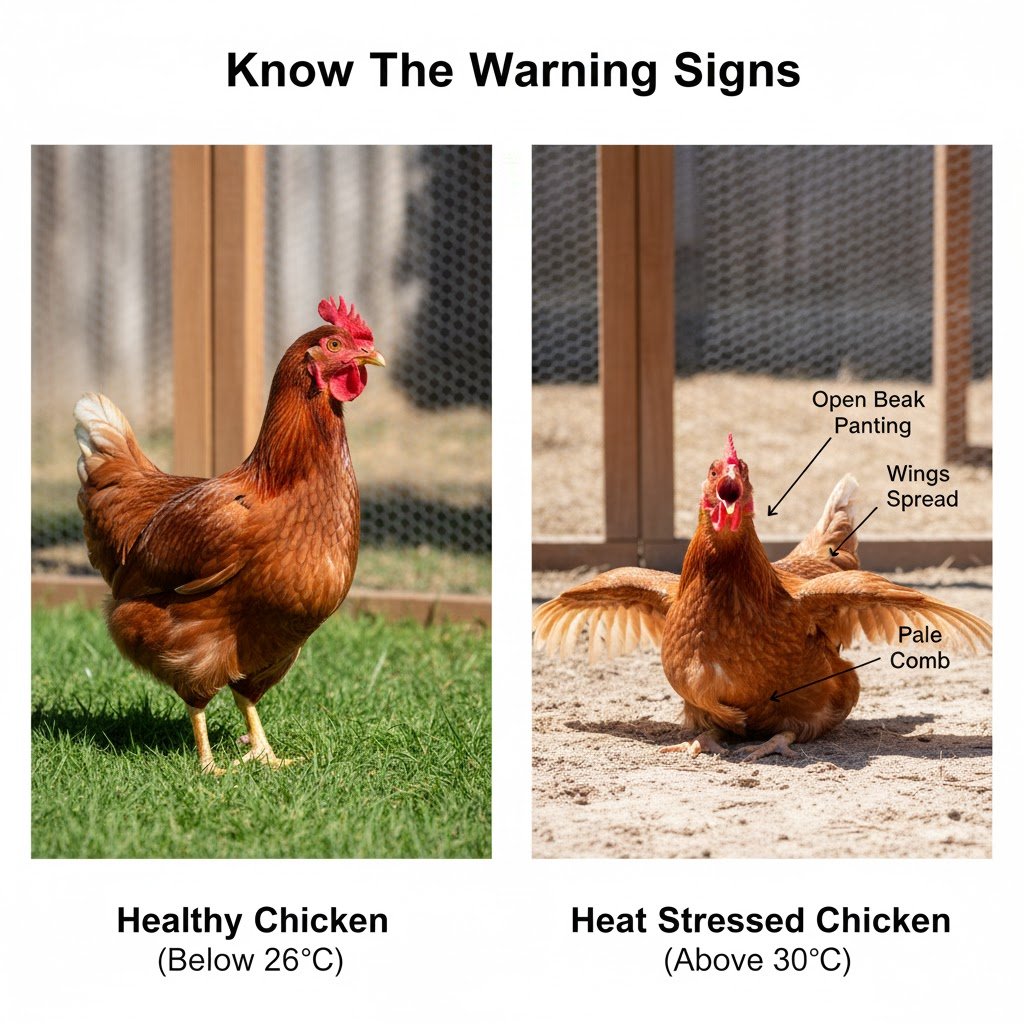
It’s important to know the signs so you can act quickly.
- Mild to Moderate Stress (30°C – 35°C):
- Panting: You’ll see them breathing with their beaks open.
- Wing Spreading: They’ll hold their wings away from their bodies to release heat.
- Pale Comb and Wattles: Their faces may look paler than usual as blood is diverted to their skin.
- Severe Stress (Above 35°C+):
- Lethargy: The chicken will be floppy, weak, and may not want to move.
- Diarrhoea: Heat stress can cause digestive upset.
For more information on management, see this guide on managing backyard chickens during extreme summer temperatures from the University of Georgia.
| Shade % | UV Block | Best For… |
|---|---|---|
| Hobby Farm Insurance Providers in Australia: |
- WFI (Wesfarmers Insurance): Offers comprehensive hobby farm coverage including poultry
- Coverage: Heat-related losses, predator attacks, disease, storm damage
- Typical Cost: $200-600/year depending on flock size
- Phone: 1300 934 934
- Nutrien Ag Solutions Insurance: Tailored policies for small-scale producers
- Coverage: Can include individual birds or entire flock
- Typical Cost: $150-500/year
- CGU Farm Insurance: Suitable for larger backyard operations
- Coverage: Property damage, mortality, public liability
- Typical Cost: Quote required
Exotic Pet Insurance for Individual Birds: If you have show chickens or valuable heritage breeds:
- Petcover Australia: Individual bird coverage available
- Budget Direct Pet Insurance: May cover chickens as exotic pets
- Typical Cost: $20-40/month per bird
Important: Always read the policy details carefully. Some policies exclude heat-related deaths during declared heatwaves. Ask specifically about coverage for:
- Heat stress mortality
- Storm damage to coops
- Predator attacks
- Disease outbreaks
- Veterinary bills for individual birds
Tax Deductions: If your chickens produce income (egg sales), your insurance premiums may be tax-deductible. Consult your accountant.
In short: Understanding the danger of heat stress is the first step. Now, let’s figure out what tool to use. Choosing the right shade cloth percentage is the most critical decision you’ll make in this process.
Is 50% Shade Cloth Too Much? Understanding Shade Percentages
This is a great question we see all the time. The short answer is: no, 50% shade cloth is not too much for most of Australia. In fact, for many places, it’s not enough.
You know what? This is where most people get it wrong. They either buy a flimsy 30% cloth (which is for seedlings) or they overcompensate and cover the entire run with a 90% cloth. The right percentage really depends on two things: your local climate and how much of the run you plan to cover. A common mistake is thinking “more is always better.” This is a bad idea. You should never cover the entire run, as this traps hot air and blocks vital airflow and ventilation. A well-ventilated run is even more important than a shaded one.
How Shade Cloth Works: Blocking vs. Reflecting
Here’s what surprised me when I first started: not all shade cloth is created equal. I thought black cloth would be hotter, but it’s not that simple.
- Knitted (Black/Green): This is the most common type. It absorbs a percentage of the sun’s light and heat. An 80% black cloth absorbs 80% of the light, getting warm itself but creating cool shade underneath.
- Aluminet (Reflective): This special, metallic-looking cloth reflects the sun’s rays. This means the cloth itself stays cooler and is more effective at lowering the air temperature, often providing 25-30% more cooling than a black cloth of the same percentage.
Shade Cloth Percentage Guide for Australian Climates
- 30-40% Shade Cloth: Honestly, this is for nurseries and delicate veggies. It’s not a serious solution for protecting chooks from a 38°C day.
- 50-60% Shade Cloth: This is a good, moderate choice for southern, milder climates like Melbourne or Tasmania, where the summer heat can be strong but isn’t a month-long relentless assault.
- 70-80% Shade Cloth: This is the sweet spot for most of Australia, including Sydney, inland NSW, South Australia, and WA. Many experienced keepers, and many chicken keepers on Reddit and Australian poultry forums, recommend 80-90% shade cloth for our harsh summers. Wind and rain still go through it well enough that it won’t collapse, as long as you install it tightly.
- 90% Shade Cloth: This offers maximum protection and is ideal for the scorching-hot, dry climates in Queensland and the Northern Territory. The key is to make sure you have excellent ventilation, as it can trap more air. I’d only use this on a run with open, wire sides.
When in doubt, check the Bureau of Meteorology (BoM) data for your area to see your average number of 35°C+ days.
Regional Shade Cloth Recommendations by Australian State
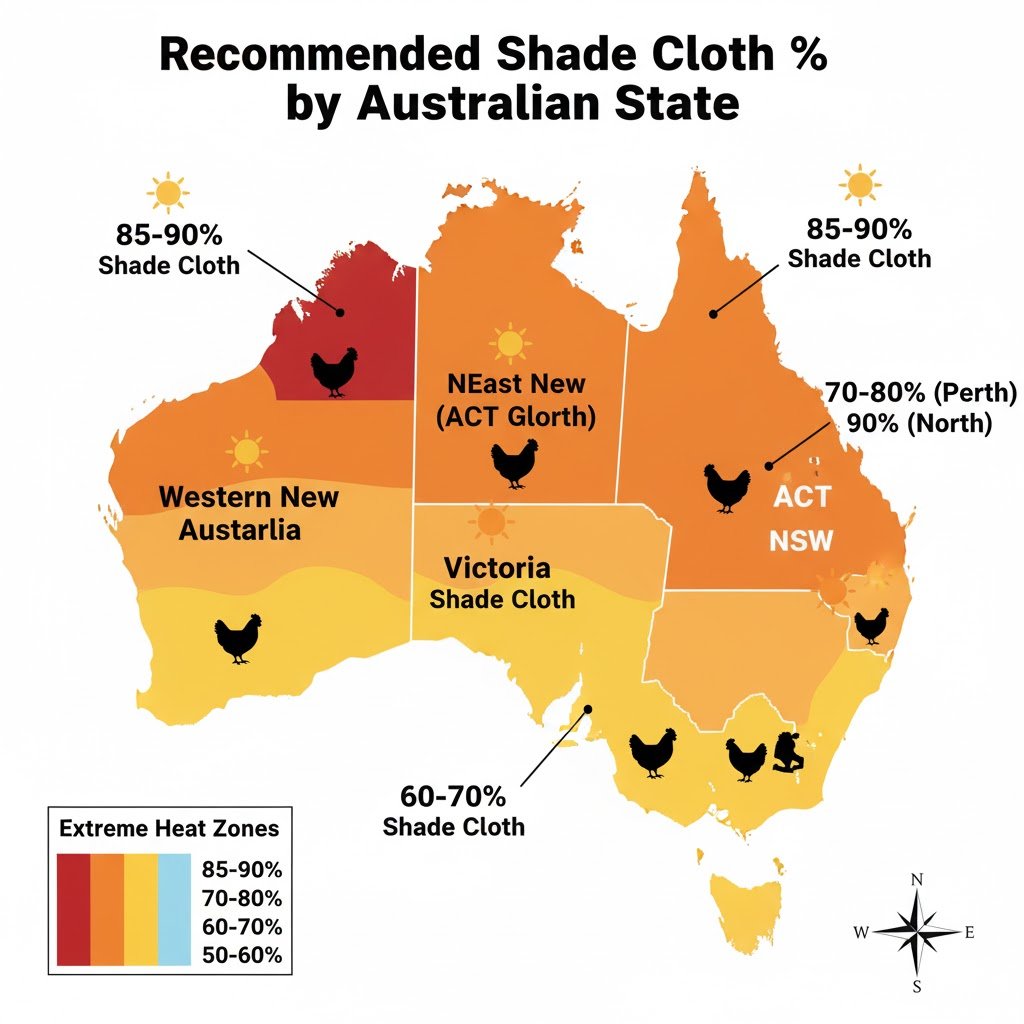
Queensland & Northern Territory
- Climate: Hot, humid summers with temperatures regularly exceeding 35°C
- Recommendation: 85-90% shade cloth, maximum ventilation
- Special Considerations: Cyclone-rated installation, marine-grade fittings in coastal areas
- Best Purchase: Local agricultural suppliers stock cyclone-rated shade cloth
New South Wales & ACT
- Climate: Hot, dry summers in west; milder coastal conditions
- Inland NSW (Dubbo, Wagga): 80% shade cloth minimum
- Sydney Metro: 70-80% shade cloth
- Coastal regions: 70% shade cloth sufficient
- Special Considerations: Bushfire-prone areas should avoid synthetic materials near vegetation
Victoria & Tasmania
- Climate: Milder summers, but still hit 35°C+ during heatwaves
- Melbourne Metro: 60-70% shade cloth
- Regional Victoria: 70% shade cloth
- Tasmania: 50-60% shade cloth, removable for winter
- Special Considerations: Wind resistance crucial; Bass Strait winds can destroy poor installations
South Australia
- Climate: Very hot, dry summers; extreme heatwaves
- Adelaide: 80% shade cloth
- Inland SA: 85-90% shade cloth
- Special Considerations: Dust storms; secure installations essential
Western Australia
- Climate: Extreme heat in north; Mediterranean in south
- Perth: 70-80% shade cloth
- Pilbara/Kimberley: 90% shade cloth, consider retractable systems
- South-West WA: 60-70% shade cloth
- Special Considerations: Intense UV radiation; premium UV-stabilized cloth recommended
Commercial research conducted on free-range farms in Australia found that hens showed clear preferences for 90% shade cloth over 70% and 50% options, with a linear relationship between shelter use and percentage of sunlight filtered.
Now that you have a good idea of which percentage matches your climate, let’s look at the specific products and best shade cloth brands 2025 on the market.
Top 5 Shade Cloth Solutions for Your Chicken Run Australia
Here’s a detailed review of the most popular shade cloth options available to Aussie chicken keepers from hardware and agricultural suppliers.
1. Aluminet Shade Cloth (The Premium Option)
This is the top-of-the-line for heat control, and you’ll know it when you see it. It’s a reflective, knitted cloth that looks like metal. Instead of just blocking the sun, it reflects it, which means the cloth itself doesn’t get as hot.
Studies suggest reflective shade cloth can provide 25-30% more cooling efficiency than standard cloth, which is a massive win on a 40°C day. It’s also surprisingly lightweight, but don’t let that fool you, it’s very durable. The only real catch is the price—it’s the most expensive option. And, fair dinkum, it can be blindingly bright on a sunny day.
2. Standard Knitted Shade Cloth – The Australian Backyard Workhorse
This is the shade cloth you’ll find at every Bunnings store across Australia, and there’s a reason it’s been the go-to choice for decades. Made from knitted UV-stabilized polyethylene, an 80% weave blocks 80% of UV rays while allowing rain and wind to pass through.
I’ve been using this on my runs for five years, and I can tell you it works. The temperature drop is noticeable – around 8-11°C on a scorching 38°C day. Yes, the cloth itself gets warm to touch, but the shade underneath stays remarkably cool.
What makes it special: The knitted construction means it won’t unravel when you cut it to size. This is crucial for custom installations. It’s also incredibly durable when installed properly – mine is entering its sixth summer and showing minimal wear.
Best for: Budget-conscious keepers who need reliable, long-term shade
Lifespan: 5-7 years with proper installation
3. DIY Shade Sail Solutions
This can be a great-looking and very effective solution, especially for larger runs. Using a standard garden shade sail (the kind you put over a deck) gives you a high-tension, durable cover that almost always offers 90%+ UV protection. Because they’re designed to be tight, they handle wind and rain beautifully.
The main challenge is the installation. Unlike just zipping-tying cloth to a run, a shade sail must have strong, well-anchored posts to handle the tension. It’s a more complex and expensive job, but the permanent, professional look is a ripper result if you’re up for it.
4. Retractable Shade Systems
If you want the ‘best of both worlds’, this is it. This is a shade cloth on a track, wire, or roller, so you can pull it back on cool days. The flexibility is fantastic, especially in winter. You can retract the shade to let in that valuable winter sun, helping to dry out the run and keep your chooks warm.
Of course, this luxury comes at a cost. These systems are more expensive, harder to install, and have moving parts that can wear out over time. But if you have the budget, the total control you get is unmatched. You can also buy shade cloth online Australia and build a DIY retractable system with some wire and turnbuckles.
- Where to Buy:
5. Budget Woven Shade Cloth (Buyer Beware)
Be careful with this one. You’ll see this at discount stores, and it looks like a bargain, but it’s often woven (not knitted). This means if you cut it, the whole thing will unravel. Worse, it’s often not properly UV-stabilised.
You might save $20 upfront, but fair dinkum, you’ll be lucky to get one summer out of it before the Aussie sun turns it brittle and it tears to shreds. I’d only ever recommend this for a very temporary, one-season fix.
- Where to Buy:
- Often found at discount stores or on Amazon Australia, but check reviews carefully.
Finding the Best Shade for Chickens: Quick Decision Guide
For Melbourne/Tasmania: 50-60% shade cloth For Sydney/Adelaide: 70-80% shade cloth For Brisbane/Darwin: 80-90% shade cloth Budget Option: 70% knitted polyethylene Premium Option: Aluminet reflective cloth
Complete Cost Breakdown for Australian Chicken Keepers
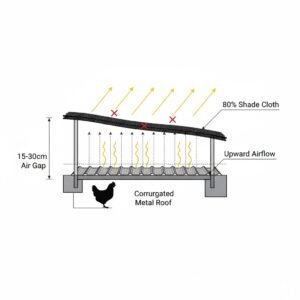
Investing in shade is one of the cheapest ways to protect your flock. Here’s a typical cost breakdown.
DIY Installation Costs (for a 3m x 4m run):
- Shade cloth (1.8m x 5m roll, 80%): $45 – $120 (depending on brand and UV rating)
- Installation materials (UV zip ties, washers, screws): $25 – $40
- Total DIY: $70 – $160
Professional Installation Costs:
- Labor (for a simple installation): $200 – $400
- Materials (custom-fit cloth): $100 – $250
- Total Professional: $300 – $650
Return on Investment (ROI):
- Reduced Mortality: A single chicken can cost $20-$50 to replace. Saving even one bird from heat stroke means the shade cloth has paid for itself.
- Improved Egg Production: Heat stress can cut egg production by 20-50%. For a flock of 6 hens, getting those extra eggs back can be worth $100-$150+ per year.
- Energy Savings: Reduced need to run electric fans or mister systems in the coop.
Once you’ve picked your product, the next step is getting it up. A bad installation can ruin even the best shade cloth, so let’s look at how to do it right.
The Best Shade Cloth Solutions for Your Chicken Run: DIY Guide
A DIY installation is a great way to save money and customise the shade for your chooks. The key is to install it tightly. A flapping shade cloth will tear itself apart in the first big storm.
Materials Needed:
- Your chosen shade cloth (buy 10-15% more than you measure)
- UV-stabilised zip ties (get the black ones; the white ones perish)
- Timber screws with large washers (the washer is key—it stops the screw from pulling through the cloth)
- Shade cloth clips (optional, but they provide a stronger anchor point than zip ties)
- Tension wire and turnbuckles (if you’re spanning a large area)
Tools Required:
- Drill
- Tin snips or heavy-duty scissors
- Tape measure
- Ladder
Step-by-Step Instructions:
- Lead with the Answer: A great DIY job starts with a good plan. Measure your run. Decide which part needs shade (hint: the west-facing side and the roof). Aim to cover 50-75% of the run, leaving the rest open for airflow and winter sun. Learn where to place your coop to maximize natural shade.
- Measure and Cut: Roll out your shade cloth on the ground. Measure twice, cut once.
- Start at One Corner: Secure the first corner tightly. If using a wooden frame, place a screw with a washer through the cloth and into the wood.
- Pull Tightly: Move to the next corner, pulling the cloth as tight as you can. You want it to be like a drum skin. A loose, saggy cloth will catch wind and water, and will fail.
- Secure the Edges: Once the corners are done, go back and secure the edges every 30-40cm with screws/washers or zip ties.
- Check for Sag: If you have a span wider than 2 metres, run a tension wire under the cloth to stop it from sagging in the middle.
DIY vs. Professional Installation
Most chicken run installations are a simple DIY job. However, if you’re installing large, high-tension shade sails, you may want to look at professional installation services.
The shade cloth installation cost Australia-wide for a professional job can vary greatly, from a few hundred dollars for a simple job to thousands for custom-made sails with new posts. If you are looking for professional installation services in Sydney or Melbourne, it’s best to get at least three quotes.
Common DIY Mistakes (And How to Avoid Them)
- Mistake 1: Covering 100% of the run. This is the biggest one. You might think “she’ll be right, more shade is better,” but it blocks all ventilation and traps hot air. Never cover more than 75% of the roof. This is one of the quickest ways to overheat your flock.
- Mistake 2: Not pulling it tight. Look, I’ve made this mistake myself. My first attempt was saggy, and it pooled with water in the first rainstorm and nearly tore the whole thing down. Pull it drum-tight. If you get it right, fair dinkum, this cloth will last you years.
- Mistake 3: Using cheap, non-UV-stabilised zip ties. They will snap within 6 months of Aussie sun. Spend the extra $5 for the UV-stabilised black ones. No worries.
Creative Chicken Run Shade Ideas Beyond Shade Cloth
- Natural Shade (The Best!): Plant a deciduous, non-toxic tree nearby. A Mulberry tree is a ripper option: fast-growing, provides deep shade in summer, drops its leaves in winter (letting sun in), and the chooks love eating the fallen berries. Grapevines or passionfruit vines on a pergola over the run are also fantastic, chook-safe options.
- Partial Roof: A shade-cloth shelter is also a good option. As a tip, go for 80 or 90% shade but don’t cover the whole run. Tie it up like a shade sail, or build a simple frame.
Professional Shade Cloth Installation Services by State
New South Wales:
- Professional installation typically costs $300-500 for a standard backyard run. Services include site assessment, custom measurements, and warranty.
- Sydney Metro: $300-550
- Regional NSW: $400-650 (travel fees may apply)
Victoria:
- Melbourne metro area: $350-600
- Regional Victoria: $400-700 (travel fees may apply)
Queensland:
- Brisbane: $300-550
- Coastal regions (e.g., Sunshine Coast, Gold Coast): Consider marine-grade installations due to salt air.
- North QLD (Townsville, Cairns): $400-700 (must be cyclone-rated fittings)
South Australia:
- Adelaide: $300-550
- Barossa/Regional SA: $350-600
Western Australia:
- Perth: $350-600
- South West & Regional WA: $400-700
Tasmania:
- Hobart/Launceston: $300-500
- Remote areas may have higher travel fees.
Northern Territory:
- Darwin: $400-700
- Installations must be rated for high-wind/cyclone standards.
[For all states] Get at least 3 quotes from local installers. Search for “shade sail installers [your city]” or “outdoor shade structures [your area].”
DIY is rewarding, but shade cloth isn’t your only tool. Let’s explore some other ways you can cool down the coop.
What Can You Use Instead of Shade Cloth?
Shade cloth is great, but a varied approach is even better. Here are some alternatives:
- Tarps (Use With Extreme Caution):
- Pros: They are 100% waterproof and block 100% of the sun.
- Cons: They are a terrible idea for heat. They block all airflow and are very noisy. A tarp can turn your run into a hot, stuffy, humid box that is far worse than no shade at all.
- Verdict: Only use a tarp for rain protection in winter, and make sure it’s well-ventilated. Do not use tarps for summer shade.
- Natural Vegetation (The Gold Standard): As mentioned, this is the best long-term solution. Planting vines like grape, passionfruit, or ornamental grape to grow over the run is fantastic. They are chook-safe (unlike toxic plants like Oleander or Azalea). They provide shade in summer and lose their leaves in winter, letting the sun in. It can be used in much the same way as shade cloth, but you don’t have to remove it.
- Solid Roof (A Smart Move):
- Pros: A permanent, 100% waterproof, 100% shaded area. Building a solid roof (e.g., Colorbond) over 1/3 to 1/2 of your run (ideally the part with the feeder and waterer) is a great investment.
- Cons: It’s a permanent, 100% shaded area. This means that part of your run will get no sun in winter, which can make it damp.
- Verdict: A combination of a 1/3 solid roof and 1/3 shade cloth (with 1/3 open) is a perfect, all-weather setup. You can design your entire coop for Australian heat with our climate-specific guide.
Providing shade is half the battle. The other half is what’s under their feet. A hot, dusty, or muddy floor will make your chooks miserable.
What is the Best Mulch for Chicken Run in Australia?
The ground cover in your run is just as important as the shade. A hot, dusty, or muddy floor is no fun for chooks. The best ground covers are ones that drain well, stay relatively cool, and help manage droppings.
- Woodchips (The Winner): This is the top choice for a “deep litter method.” Fill your run with a deep layer of woodchips—at least 5-6 inches (12-15cm) for effective composting, though a minimum of 2 inches will provide basic benefits. The key is to get hardwood chips from a tree lopper (often free!) or a landscape supplier. The droppings fall through, and microbes in the chips break them down, so there’s almost no smell. Do not use bark or woodchips containing bark. Bark is a mulch designed to sponge up water, and it can release harmful aspergillosis spores. Also, avoid fine pine shavings, which get dusty and can cause respiratory issues.
- Cypress and Pine: Many Aussie keepers find cypress mulch topped with pine chips to be a wonderful thing for the ground in the run. Cypress has natural insect-repelling properties. | Winter | Warms up as it composts. | Stays cold and can get compact. |
Verdict: For most keepers, a deep layer of hardwood chips is the easiest, lowest-smell, and most beneficial option. Barn lime is another option for managing moisture and odor in your run.
Australian Animal Welfare Standards Compliance
The Australian Animal Welfare Standards and Guidelines for Poultry (2022) require:
- Standard SA 5.2: “A person in charge must ensure poultry kept in housing with access to an outdoor area have ready access to the housing and shaded areas.”
- Standard SA 5.3: By 1 July 2025, outdoor areas must provide “access to appropriately located shade and shelter from predators.”
- Guideline GA 5.3: “Shade and shelter in an outdoor area can be provided by vegetation such as shrubs or trees and structures such as shade cloth, straw bales and shipping pallets on blocks.”
Compliance Status: As of November 2025, all Australian backyard chicken keepers must now comply with these shade requirements. Non-compliance can result in:
- Council investigations
- Animal welfare complaints
- Fines ranging from $500-$5,000 depending on state
- Mandatory compliance orders
What changed in 2025: The grace period for existing setups ended on 1 July 2025. If you haven’t yet installed shade, you are technically non-compliant with national animal welfare standards.
What this means for you: Installing adequate shade is not just good practice – it’s a legal requirement for backyard chicken keepers across Australia. Local councils can enforce these standards, and failure to provide adequate shade could result in animal welfare investigations.
Council Permits: Most councils don’t require permits for shade cloth installations under 10m², but check your local regulations, especially if:
- Installing permanent posts in concrete
- Structures exceed 2.4m height
- Near property boundaries
Understand your legal requirements for keeping chickens in Australia before you build.
You’ve got your shade, you’ve got your ground cover. The last step is making sure it’s all safe and will last for years to come.
The Golden Rule: Ventilation FIRST, Shade Second
Providing shade is vital, but I’ll say it again: ventilation is more important. You MUST have good airflow. A shaded run with no airflow is a hot, humid, dangerous box. Read our complete guide to chicken coop ventilation.
- Never cover the entire run.
- Always leave gaps or sides open for air to move.
- Position your shade to block the radiant heat from the sun (especially the western afternoon sun) while still allowing convective breezes to flow through.
- An air gap between a roof and a shade cloth is a great way to do both.
How to Provide Shade in a Chicken Run Safely
- Install Securely: A loose cloth flapping in the wind can frighten your chickens and will eventually tear. Secure it tightly.
- Wind Resistance: Don’t cover 100% of the roof. Leaving 25-50% open allows wind to pass through, rather than turning your shade cloth into a giant kite.
- Check for Drips: Make sure your shade doesn’t funnel rainwater directly into the driest part of the run or near the feeder.
- Learn about common ventilation errors to avoid to ensure your setup is safe.
Year-Round Maintenance Schedule
- Monthly: Check tension. A quick walk-around to tighten zip ties or turnbuckles.
- Quarterly (Start of Season): Check for any rips, tears, or sun-fading. Hose down the cloth to remove dust and debris.
- Annually (Start of Winter): Consider removing your shade cloth if it’s not a permanent fixture. This allows the winter sun to dry out the run and kill bacteria.
Seasonal Shade Management Calendar for Australia
Managing your shade is not a “set it and forget it” task. Adjusting it with the seasons is key to a healthy run.
- Spring (Sept-Nov):
- This is the time to install. Aim to have your shade cloth up before the first 30°C day.
- Check and re-tighten any fittings that may have loosened during winter storms.
- Summer (Dec-Feb):
- Your shade should be at maximum coverage (50-75% of the run).
- Check weekly that ventilation is still good and not blocked.
- Monitor your flock for heat stress daily during heatwaves.
- Autumn (Mar-May):
- As the days cool, this is a good time for maintenance. Hose down the cloth to remove dust and poop.
- In southern states (VIC, TAS), you can consider partial removal to let in more sun.
- Winter (Jun-Aug):
- Remove or retract shade cloth in most areas.
- Winter sun is critical. It dries out the run (preventing mud and bacteria), kills pathogens, and keeps your chickens warm. Research from Purdue University notes that chickens’ ideal temperature range starts at 15°C, so providing direct sun in winter is vital for their health.
Where to Buy Quality Shade Cloth in Australia
While Bunnings and Amazon are convenient, don’t forget to check specialist suppliers, as they often have higher-quality, more durable, and wider rolls of cloth.
- All States (National):
- Bunnings Warehouse: Good for standard-duty knitted cloth and shade sails.
- Amazon Australia: Wide variety, but check reviews to ensure it’s UV-stabilised.
- Rural & Regional NSW, VIC, QLD, WA, SA:
- Local Agricultural Suppliers: Search for “Nutrien Ag Solutions,” “Elders,” or similar stores. They often stock professional-grade (70-90%) cloth.
- Rural Fencing & Produce Stores: Your local “feed and seed” store often has heavy-duty options.
- Horticultural & Nursery Suppliers: Search for “horticultural supplies” as they sell commercial-grade cloth for greenhouses, which is perfect for chooks.
We’ve covered a lot of ground. Let’s finish by pulling all the most common questions into one place for a quick review.
Your Chicken Shade Questions Answered (FAQ)
How to provide shade in a chicken run?
Install 70-80% shade cloth covering 50-75% of the run area, leaving 25-50% open for ventilation. Position the shade cloth 15-30cm above any existing roof to create an air gap. Secure it tightly with UV-stabilized zip ties or screws with washers every 30-40cm.
Is 50% shade cloth too much?
No, 50% shade cloth is not too much and is a good minimum for milder Australian climates. For hotter regions like Queensland and WA, 70% or 80% is better for preventing heat stress in chickens. Never cover 100% of the run, as this stops ventilation.
What can you use instead of shade cloth?
Alternatives to shade cloth include permanent solid roofing (like Colorbond) over 1/3 to 1/2 of the run, or planting natural, chook-safe vines like Grape or Passionfruit. Do not use tarps for summer shade, as they trap heat and stop all airflow.
How much will 40 shade cloth reduce temperature?
A 40% shade cloth reduces chicken run temperatures by only 2-4°C and is unsuitable for protecting poultry from Australian heat. It is designed for nursery plants, not livestock. For effective heat stress prevention in chickens, use a minimum of 70-80% shade cloth, which reduces temperatures by 8-11°C under ideal conditions (full sun, low humidity, proper air gap installation).
What is the best thing to put on the ground in a chicken run?
The best ground cover for an Australian chicken run is a deep layer (6-8 inches) of hardwood woodchips (not bark). This “deep litter method” drains well, stays cool, and controls smell by naturally composting waste. Sand is the second-best option.
Can I use shade cloth in winter?
It is best to remove shade cloth in winter if possible. Chickens need the winter sun to stay warm and to help dry out the run, which prevents mud and bacteria. If your shade cloth is permanent, ensure at least 50% of the run is open to the sky.
Where to buy shade cloth in Australia?
You can buy shade cloth online Australia from retailers like Amazon and specialist agricultural suppliers. You can also buy it in-store at major hardware chains like Bunnings or at local rural supply stores.
Measuring Your Success: Is Your Shade Working?
Here’s how to verify your shade cloth installation is effective:
Temperature Monitoring:
- Place a thermometer in the shaded area and one in full sun
- Measure at 2pm on a 35°C+ day
- Target: At least 8-10°C difference
- If difference is less than 5°C, you may need higher percentage cloth or better air gap
Chicken Behavior Indicators:
- ✅ Chickens spend hot afternoons in shaded area
- ✅ Minimal panting even at 32°C
- ✅ Continued egg production through summer
- ✅ Active foraging in early morning/late afternoon
- ❌ Chickens avoid the run and crowd in one corner
- ❌ Heavy panting even in shade
- ❌ Complete stop in egg production
Conclusion: Your Complete Aussie Chook Comfort Plan
Ultimately, keeping your chickens safe and comfortable during a harsh Australian summer isn’t just about one thing. The best shade cloth solutions are a critical, non-negotiable part of that plan.
By choosing the right percentage for your climate (like 70-80% for most), installing it tightly, and—most importantly—balancing it with excellent ventilation, you’re creating a safe haven for your flock. But don’t stop there. Great shade works best when combined with cool, deep ground cover like woodchips and a constant supply of fresh, cool water. Pair shade with the right waterers that keep water cool in Aussie heat.
Your chooks rely on you to protect them from the elements. With a well-planned run, you can stop worrying about the heatwaves and just enjoy the company of your happy, healthy, and productive flock.

Oladepo Babatunde is the founder of ChickenStarter.com. He is a backyard chicken keeper and educator who specializes in helping beginners raise healthy flocks, particularly in warm climates. His expertise comes from years of hands-on experience building coops, treating common chicken ailments, and solving flock management issues. His own happy hens are a testament to his methods, laying 25-30 eggs weekly.
![Best Shade Cloth for Chicken Runs Australia 2025 [Complete Guide]](https://chickenstarter.com/wp-content/uploads/2025/11/Best-Shade-Cloth-for-Chicken-Runs-Australia-2025-Complete-Guide-1.jpg)
